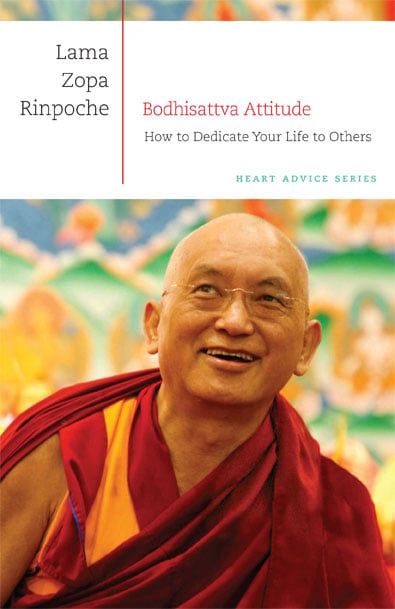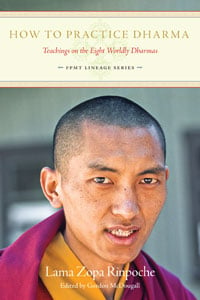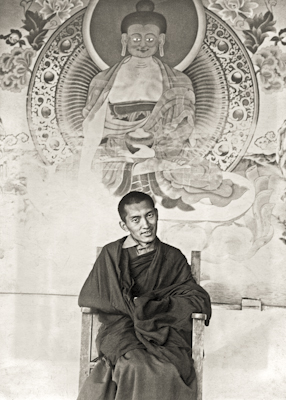Dear LYWA friends and supporters,
We are delighted to bring you our June e-letter. Thank you so much for subscribing to it. We appreciate your kind interest.
More praise for Bodhisattva Attitude
Lama Zopa Rinpoche’s Bodhisattva Attitude, the first book in our new Heart Advice Series, has been receiving rave reviews! Here's one from the Guhyasamaja Center blog and a shorter version of it on Amazon. Please add yours on the Amazon site...it's really helpful for us and will bring the book to more people's attention. And more readers are saying:
And more readers are saying:
What a delightful present to pop through the mailbox yesterday! The book looks fabulous! I think you’ve done a wonderful job of presenting it, with the teaching and motivations separately. Great photos, too!
Really wonderful, so inspiring.
I want to thank you for the wonderful gift you sent to me, Lama Zopa's new book, Bodhisattva Attitude. I have had it sitting beside me for a few days (since it arrived) and I find myself reading small pieces (like this morning, I went to 'How to Start the Day with Bodhicitta,' before I began my practice --and it was so amazing, specific, directed). It is a really awesome piece of work, and I think it may be like having our teacher beside us all of the time....I just want to thank you again for producing this wonderful teaching and teacher, and for your kindness in sending this book to me.
If you haven't gotten your copy yet, you can order it from our website or download the ebook from Amazon.com.
Our Next Book: How to Practice Dharma We are excited to announce that Lama Zopa Rinpoche’s next book, How to Practice Dharma: Teachings on the Eight Worldly Dharmas is at the printer. We’ll be sending it out to Members by the end of July. Please let us know if you'd prefer your copy to be an ebook.
We are excited to announce that Lama Zopa Rinpoche’s next book, How to Practice Dharma: Teachings on the Eight Worldly Dharmas is at the printer. We’ll be sending it out to Members by the end of July. Please let us know if you'd prefer your copy to be an ebook.
This is the second book in our FPMT Lineage Series, a series of books of Lama Zopa Rinpoche’s teachings on the graduated path to enlightenment (lam-rim). They are drawn from four decades of Rinpoche's discourses on the topic based on his own textbook, The Wish-fulfilling Golden Sun, and several traditional lam-rim texts.
This series is the most extensive contemporary commentary on the path to enlightenment teachings available and comprises the essence of the FPMT's education program. The first in this series was Rinpoche's fabulous Heart of the Path.
FPMT Lineage Series books are not free but are very reasonably priced. How to Practice Dharma, 256 pages long, will be only $10 and will be automatically sent free of charge to LYWA Members. Please see our Membership page if you would like to have this and all our other Lama Yeshe and Lama Zopa Rinpoche books (as well as those published by Wisdom Publications) sent to you free upon publication.
Our New YouTube channel We have created a new LYWA YouTube channel, where we’ll be posting for the first time full-length versions of our DVDs. Subscribe to our new channel, LamaYesheWisdom, to be notified as we add new videos.
We have created a new LYWA YouTube channel, where we’ll be posting for the first time full-length versions of our DVDs. Subscribe to our new channel, LamaYesheWisdom, to be notified as we add new videos.
In addition to full-length videos, you can now see for the first time, never released on DVD or video, Lama Yeshe’s wonderful Christmas Teaching, 25 December 1982, at Istituto Lama Tzong Khapa. In the 1970s, Lama had a sporadic tradition of giving a Christmas talk at Kopan and these were edited into the 1978, now out of print book, Silent Mind, Holy Mind, currently available from LYWA as a PDF. This 1982 talk was obviously not included. So, with sincere thanks to our DVD producer Ven. Bob Alcorn, you can now enjoy watching this subtitled version in full, "Lama Yeshe Christmas 1982: Part 1."
But wait! There’s more! At the end of this teaching, while students came up to Lama one-by-one to receive his blessings and a three-deity long life tsa-tsa, a gompa Christmas party began, and you can watch the IMI monks and nuns trying to let their non-existent hair down in the background... accompanied by their more hirsute lay brothers and sisters. So this is entitled "Lama Yeshe Christmas 1982: Part 2."
What's New On Our Website
Listen online to Lama Zopa Rinpoche's extensive teachings on karma, excerpted from a series of teachings given at Maitreya Instituut, Emst, Netherlands in August 1990. Rinpoche gives commentary on each of the 10 non-virtuous actions and how to purify them, interspersed with teachings on impermanence and emptiness. This is the first time we've posted such extensive teachings on this topic on our website-- check them out!
Speaking of karma and purification, we have also just posted teachings on Purifying with the Four Powers, which Rinpoche gave at Kopan Monastery in May 1987, and a teaching on Karma and Finding Happiness, a public talk given in San Francisco, California in October 1990.
Thanks to Sandy Smith, our intrepid Web Editor, even more of Rinpoche's teachings were added to our website this month:
-
Teachings during Amitabha and White Tara long-life initiations and retreat at Shakyamuni Center, Taichung, Taiwan in February 2007.
-
A teaching on the mind, the death process and the ultimate nature of the I, given in London, England in August 1990.
-
A teaching on bodhicitta, given in Madison, Wisconsin in July 1999.
-
And as usual there were also many new advices added to the Online Advice Book. See here for a list of all new advices added this month.
Don't want to wait until the monthly eletter to find out about all these great new teachings added to our website? Sign up for email alerts and receive a weekly email with links to new teachings, on all topics or only on those topics you choose.
Advice for Monks and Nuns Re-Published in Ebook Format and Print-On-Demand The classic LYWA publication, Advice for Monks and Nuns, has been out of print for many years. We are pleased to announce its re-publication in ebook format and for print-on-demand!
The classic LYWA publication, Advice for Monks and Nuns, has been out of print for many years. We are pleased to announce its re-publication in ebook format and for print-on-demand!
Freshly updated, ebook versions are available for Kindle from Amazon.com, and to our Members for free in our Members' Area. It will soon be available for other readers, like Nook and Sony.
You can also order a copy from our print-on-demand vendor Lulu.com.
Remember, as with all our free books, anyone can download the book as a pdf or read it online on our website.
Speaking of LYWA publications as ebooks, we recently learned that our friends at the FPMT French-language publisher Editions Vajra Yogini have published some of our free books as ebooks: How Things Exist, Becoming Your Own Therapist, and Peaceful Stillness of the Silent Mind. You can see a list of all LYWA publications translated into French on our website; you can also see a list of all our foreign language translations.
Compassion Day
For the first time, North American FPMT centers will be celebrating Compassion Day on July 6 in honor of His Holiness the Dalai Lama’s birthday. The Centers are working together to organize a day of events, activities and practices to celebrate compassion. To find out how you can participate visit their website CompassionDay.org. Compassion Day also has its own Facebook page.
And LYWA is doing its part! We are offering copies of our free Lama Zopa Rinpoche books Bodhisattva Attitude and The Joy of Compassion completely post-free to customers in North America if ordered on that day, July 6, only.
108 Yaks
When I was in Singapore earlier this year I had the pleasure of staying at the wonderful Amitabha Buddhist Centre. Kopan’s Geshe Thubten Jinpa was also there, working with Tan Seow Kheng on his DVD 108 Yaks: A Journey of Love and Freedom, which documents how, on Lama Zopa Rinpoche’s advice, he rescues over 100 yaks from slaughter. With an intrepid band of yak herders, Geshe Jinpa shepherds the yaks over high mountain passes and through dangerous rivers to freedom in the Rolwaling Valley, where the killing of animals is forbidden and where Lama Zopa Rinpoche spent several years of his young life studying in the monastery under the loving but wrathful tutelage of his uncle. A DVD well worth getting. Please get it!
This month we leave you with an excerpt from our forthcoming book How to Practice Dharma. Thank you so much for your interest in and support of the Archive. We couldn’t do it without you.
Much love,
Nick Ribush
Director
This Month's Teaching: The Importance of Knowing What Dharma Is
 Even if we understand nothing else, if, by recognizing the eight worldly dharmas, we can clearly differentiate between what is Dharma and what is not Dharma, we’re very fortunate. This is the essential point. This knowledge alone gives us a great chance to really put Dharma practice into our daily life and create an incredible amount of merit.
Even if we understand nothing else, if, by recognizing the eight worldly dharmas, we can clearly differentiate between what is Dharma and what is not Dharma, we’re very fortunate. This is the essential point. This knowledge alone gives us a great chance to really put Dharma practice into our daily life and create an incredible amount of merit.
Buddhism is a house full of treasures—practices for gaining the happiness of future lives, the bliss of liberation and the supreme happiness of enlightenment—but knowing the difference between Dharma and non-Dharma is the key that opens the door to all those treasures. No matter how much we know about emptiness, the chakras or controlling our vital energy through kundalini yoga, it’s all pointless without this crucial understanding of how to practice Dharma, how to correct our actions. There are vast numbers of people who delude themselves and waste their entire life studying the most esoteric aspects of Buddhism but never understand the most fundamental point, the distinction between Dharma and non-Dharma.
It is very easy to do Dharma activities such as reciting mantras, saying prayers, making offerings and things like that with the thought of the eight worldly dharmas. That happens. But in reality, the holy Dharma, which includes all these activities, actually means renouncing this life. Therefore holy Dharma and worldly dharma can never be done together. Nobody can do these two things—renounce this life and seek the happiness of this life with the eight worldly dharmas—at once. We can do one and then the other but never both together in the one mind at the same time.
It’s better to practice Dharma
Whenever different benefactors wrote to Pabongka Dechen Nyingpo asking for advice, it seems that he always advised them to persuade other sentient beings to practice Dharma, especially lam-rim, as much as possible, by giving the very heart instructions on how to make their life most meaningful.
Because the eight worldly dharmas are the source of every problem we ever encounter, if Dharma practice means renouncing suffering it means renouncing the eight worldly dharmas. "I'm practicing Dharma" really means "I'm renouncing all the suffering of this and all future lives; I'm renouncing the thought of the eight worldly dharmas."
In previous times, Dromtönpa, Atisha’s close disciple and translator, saw an old man walking around the temple at Reting (Radreng) Monastery. The old man thought that he was practicing Dharma. So Dromtönpa said, "Circumambulating the temple is good, but wouldn't it be better to practice Dharma?" After hearing this the old man gave up going around the temple and started reading scriptures, thinking that that was what practicing Dharma meant. Again Dromtönpa saw him and said, "Reading the scriptures is good, but wouldn't it be better to practice Dharma?" At that the old man gave up reading Dharma texts and, thinking that maybe meditation was practicing Dharma, sat cross-legged with his eyes closed. Again Dromtönpa saw him and said, "Meditation is good, but wouldn't it be better to practice Dharma?"
This made the old man really confused. He couldn’t think of any other way of practicing Dharma if it wasn’t circumambulating, reading scriptures or meditating. So, a little exasperated, he exclaimed to Dromtönpa, "Practice Dharma! Practice Dharma! What do you mean, practice Dharma?" Dromtönpa replied, "Renounce this life. Renounce it now, for if you do not renounce attachment to this life, whatever you do will not be the practice of Dharma because you will not have passed beyond the eight worldly dharmas. Once you have renounced this life’s habitual thoughts and are no longer distracted by the eight worldly dharmas, whatever you do will advance you on the path of liberation."
Dromtönpa advised the old man to renounce this life because without renouncing this life nobody can practice pure Dharma. With renunciation, however, pure Dharma practice, which brings happiness in this and all future lives, is possible. Renouncing this life doesn't mean running away from home or throwing away all our material possessions; it means running away from the cause of the suffering. That alone can cut our suffering. As long as we follow the eight worldly dharmas, whether we separate from this physical body or not, without question we will still suffer.
In a similar vein, when Lama Atisha was about to pass away, one of his followers, a yogi called Naljor Chaktri Chok, said to him, "After you have passed away I will dedicate myself to meditation." Lama Atisha answered, "Give up anything that is a bad action." Atisha did not say whether it was good or bad to meditate, just to give up all bad actions. Naljor Chaktri Chok then said to Atisha, "In that case, sometimes I will explain Dharma and sometimes I will meditate." Again Atisha gave the same answer. The yogi thought some more, then made another suggestion. But no matter what he said, Atisha just kept on giving him the same answer. Finally he asked, "Well, what should I do?" Lama Atisha answered, "Give up this life in your mind!"
Keeping this advice in his heart, Naljor Chaktri Chok lived in a juniper forest rear Reting Monastery, physically no different from the way the forest animals lived. Living alone, not seeing even one other human face, he passed his life there.
But giving up this life doesn't necessarily mean leaving everything behind and escaping from this world, this entire planet, and going somewhere else. Giving away all our possessions—even all the possessions that exist in the world—is not giving up this life. Taking our body away from our home or country is not giving up this life. Even living in a cave with no possessions at all, with only the body, is not giving up this life. Even separating from our body—as we do every time we die—is not giving up the worldly life. Giving up this life does not depend on physical things; it is a mental change.
Excerpted from Lama Zopa Rinpoche's How to Practice Dharma: Teachings on the Eight Worldly Dharmas, edited by Gordon McDougall. Forthcoming in July 2012 from the Lama Yeshe Wisdom Archive.





























